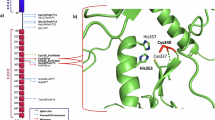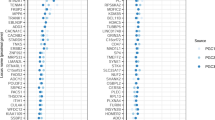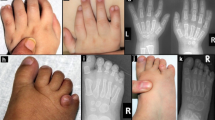Abstract
Partial absence of the sacrum is a rare congenital defect that also occurs as an autosomal-dominant trait, whereas imperforate/ectopic anus is a relatively common malformation, usually observed in multiple congenital anomalies syndromes. We report on a girl born to healthy consanguineous parents (first cousins once removed) with anal imperforation and associated rectovaginal fistula and partial sacral agenesis. Facial dysmorphism included a high forehead, epicanthic folds, downslanting palpebral fissures, hypertelorism and a depressed nasal root. Brain MRI showed a bilateral opercular dysplasia with a unilateral (right) pachygyria; MRI and X-ray imaging of the spine disclosed a tethered cord associated with partial sacral agenesis. She showed a moderate developmental delay. Ophthalmologic examination evidenced bilateral microphthalmos and relative microcornea. Cytogenetic studies in our patient disclosed a pure de novo 6q25.3 → qter deletion. By genotype analysis, we detected in our patient a maternal allele loss encompassing D6S363 and D6S446. Pure distal 6q deletion is a rare anomaly, reported in association with sacral/anorectal malformations (sacral agenesis, anal imperforation/ectopia) and never with cortical dysplasia. Pooling deletion mapping information in patients with pure terminal and interstitial 6q deletion allowed us to define a critical region spanning 0.3 Mb between the markers D6S959 and D6S437 for sacral/anal malformations. We hypothesize that haploinsufficiency for a gene within the deleted region may impair normal development of caudal structures, possibly acting on the notochordal development.
Similar content being viewed by others
Log in or create a free account to read this content
Gain free access to this article, as well as selected content from this journal and more on nature.com
or
References
Hopkin RJ, Schorry E, Bofinger M et al: New insights into the phenotypes of 6q deletions. Am J Med Genet 1997; 70: 377–386.
McLeod DR, Fowlow SB, Robertson A et al: Chromosome 6q deletions: a report of two additional cases and a review of the literature. Am J Med Genet 1990; 35: 79–84.
Lorda-Sanchez I, Lopez-Pajares I, Roche MC et al: Cryptic 6q subtelomeric deletion associated with a paracentric inversion in a mildly retarded child. Am J Med Genet 2000; 95: 336–338.
Anderlid BM, Schoumans J, Anneren G et al: FISH-mapping of a 100-kb terminal 22q13 deletion. Hum Genet 2002; 110: 439–443.
Stevenson DA, Brothman AR, Carey JC et al: 6q subtelomeric deletion: is there a recognizable syndrome? Clin Dysmorphol 2004; 13: 103–106.
Narahara K, Tsuji K, Yokoyama Y et al: Specification of small distal 6q deletions in two patients by gene dosage and in situ hybridization study of plasminogen and alpha-L-fucosidase 2. Am J Med Genet 1991; 40: 348–353.
Meng J, Fujita H, Nagahara N et al: Two patients with chromosome 6q terminal deletions with breakpoints at q24.3 and q25.3. Am J Med Genet 1992; 43: 747–750.
Evers LJ, Schrander-Stumpel CT, Engelen JJ et al: Deletion of the long arm of chromosome 6: two new patients and literature review. Clin Genet 1996; 50: 138–144.
Rubtsov N, Senger G, Kuzcera H et al: Interstitial deletion of chromosome 6q: precise definition of the breakpoints by microdissection, DNA amplification, and reverse painting. Hum Genet 1996; 97: 705–709.
Pirola B, Bortotto L, Giglio S et al: Agenesis of the corpus callosum with Probst bundles owing to haploinsufficiency for a gene in an 8 cM region of 6q25. J Med Genet 1998; 35: 1031–1033.
Sukumar S, Wang S, Hoang K et al: Subtle overlapping deletions in the terminal region of chromosome 6q24.2–q26: three cases studied using FISH. Am J Med Genet 1999; 87: 17–22.
Lukusa T, Willekens D, Lukusa N et al: Terminal 6q25.3 deletion and abnormal behaviour. Genet Counsel 2001; 12: 213–221.
Stemple DL : Structure and function of the notochord: an essential organ for chordate development. Development 2005; 132: 2503–2512.
Qi BQ, Beasley SW, Frizelle FA : Evidence that the notochord may be pivotal in the development of sacral and anorectal malformations. J Pediatr Surg 2003; 38: 1310–1316.
Giglia-Mari G, Coin F, Ranish JA et al: A new, tenth subunit of TFIIH is responsible for the DNA repair syndrome trichothiodystrophy group A. Nat Genet 2004; 36: 714–719.
Chuang YY, Tran NL, Rusk N et al: Role of synaptojanin 2 in glioma cell migration and invasion. Cancer Res 2004; 64: 8271–8275.
Schimenti JC, Reynolds JL, Planchart A : Mutations in Serac1 or Synj2 cause proximal t haplotype-mediated male mouse sterility but not transmission ratio distortion. Proc Natl Acad Sci USA 2005; 102: 3342–3347.
Author information
Authors and Affiliations
Corresponding author
Rights and permissions
About this article
Cite this article
Titomanlio, L., Giurgea, I., Baumann, C. et al. A locus for sacral/anorectal malformations maps to 6q25.3 in a 0.3 Mb interval region. Eur J Hum Genet 14, 971–974 (2006). https://doi.org/10.1038/sj.ejhg.5201635
Received:
Revised:
Accepted:
Published:
Issue date:
DOI: https://doi.org/10.1038/sj.ejhg.5201635
Keywords
This article is cited by
-
Currarino syndrome: a comprehensive genetic review of a rare congenital disorder
Orphanet Journal of Rare Diseases (2021)
-
Interstitial deletion of 6q25.2–q25.3: a novel microdeletion syndrome associated with microcephaly, developmental delay, dysmorphic features and hearing loss
European Journal of Human Genetics (2009)



